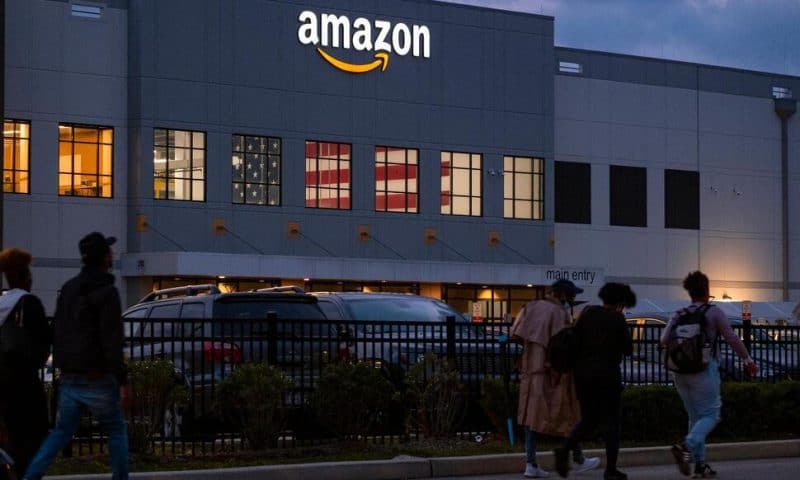A report released by Senator Bernie Sanders says Amazon’s popular Prime Day sales event has been “a major cause of injuries” for warehouse workers who pick and pack customer orders at the company’s facilities across the U.S. The report released to coincide with the start of Prime Day on Tuesday says nearly 45 out of 100 workers were injured during the two-day sales event in 2019
NEW YORK — Amazon’s popular Prime Day sales event has been “a major cause of injuries” for warehouse workers who pick and pack customer orders at the e-commerce giant’s facilities across the United States, according to a report released Tuesday by Sen. Bernie Sanders.
The report, which draws information from a year-long Senate committee investigation into Amazon’s safety practices and relied on internal company data from 2019 and 2020, said peak shopping times – including the holiday shopping period – resulted in the “highest weekly injury rates” for warehouse workers.
The preliminary report from Sanders’ office was also based on interviews with more than 100 current and former Amazon employees. This year’s two-day Prime Day event started Tuesday.
In a statement, Sanders said the “incredibly dangerous working conditions at Amazon” highlighted in the report are a “perfect example of the type of corporate greed that the American people are sick and tired of.”
“Despite making $36 billion in profits last year and providing its CEO with over $275 million in compensation over the past three years, Amazon continues to treat its workers as disposable and with complete contempt for their safety and well-being,” said the Vermont independent, who has been critical of Amazon and supports worker efforts to unionize at the company. “That is unacceptable, and that has got to change.”
Labor unions and safety experts have long criticized Amazon, alleging the company’s focus on speed and fast deliveries puts workers in danger. In recent years, some states have passed laws aimed at Amazon to curb the use of warehouse productivity quotas, though the company claims it doesn’t employ them.
According to the Senate report, 45 out of 100 warehouse at Amazon received injuries during the 2019 Prime Day event. The number included minor injuries the company was not required to disclose to the federal government, such as bruises and superficial cuts, but also serious ones such as concussions that should have been reported, it said.
Amazon disputed the finding.
“The claims that we systemically underreport injuries, and that our actual injury rates are higher than publicly reported, are false,” Amazon spokesperson Kelly Nantel said in a prepared statement. “We’re required to report every injury that needs more than basic first aid, and that’s what we do.”
While Amazon “might make an occasional clerical error,” a six-month federal investigation by the Occupational Safety and Health Administration found “no intentional, willful, or systemic errors” in the company’s reporting, Nantel said.
The report also alleged that Amazon had a practice of failing to refer workers for outside medical care because doing so could affect whether an injury should be considered “recordable” and referred to OSHA. Even when injuries were serious and might have required extra medical attention, workers often received first aid before being sent back to work instead of to a doctor, it said.
Amazon has acknowledged in the past that its warehouse injury rates had been higher compared to its peers. Federal safety investigators levied fines against the company in recent years following inspections at some of its warehouses. Some of the inspections arose from referrals made to the U.S. Attorney’s Office for the Southern District of New York, which is also investigating worker safety at the company through its civil division.
Last month, California fined Amazon a total of $5.9 million, accusing the company of violating the state’s Warehouse Quota Law at two facilities.
A spokesperson for Sanders’ office said the committee relied on 2019 and 2020 workplace injury rate data because that’s what Amazon provided for the inquiry.
However, Amazon spokesperson Nantel said that the Senate review ignored the progress the company has made since 2019 in reducing its rate of recordable incidents – those which require more care than basic first aid – by 28%. The company also has improved the rate of significant injuries that require an employee to miss at least a day of work by 75%, she said.
“We’ve cooperated throughout this investigation, including providing thousands of pages of information and documents,” Nantel said. “But unfortunately, this report (which was not shared with us before publishing) ignores our progress and paints a one-sided, false narrative using only a fraction of the information we’ve provided. It draws sweeping and inaccurate conclusions based on unverified anecdotes, and it misrepresents documents that are several years old and contained factual errors and faulty analysis.”
The report also says Amazon failed to adequately staff its warehouses during peak shopping times, which the company disputed. Amazon said in March that it allocated over $750 million to safety efforts for this year.

